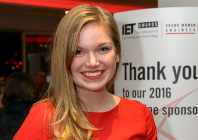Whether you’re still in education or a few rungs up the career ladder, we could all do with inspiration to show us what is achievable and to gain an insight into what others are doing in the field of design and engineering. 
This month our role model is Jenni Sidey, who despite being young has already achieved a great deal, including being applauded as an advocate for women in engineering.
Having studied Mechanical Engineering at McGill University in Montreal, Canada, Jenni Sidey moved to the UK in 2011 to take up a Ph.D. at the University of Cambridge studying combustion as part of the Rolls-Royce University Gas Turbine Partnership. She was appointed as a university lecturer in the Department of Engineering in 2016 and is now a fellow of St. Catharine’s College. Her research interests include alternative fuel development and pollutant reduction for energy and transport combustion devices.
In December 2016, she won the Institution of Engineering and Technology’s (IET) Young Woman Engineer of the Year Award for her professional success and work as an advocate for women in engineering. She is also one of the final 17 candidates for the ongoing 2016/17 Canadian Space Agency’s Astronaut Recruitment Campaign.
What do you most enjoy about your job?
I love teaching, so interacting with students and passing on knowledge is a highlight of my current role.
What inspired you to become an engineer?
I was inspired to become an engineer once I learned what the profession really was from my uncle, a civil engineer. He recognised early on that I could solve problems in unique and creative ways, plus I was interested in science. He made an effort to involve me in projects he thought I’d find interesting. Once I learned from him that engineering was a profession which applied science to solve problems creatively, I was hooked.
What has been one of the biggest challenges you’ve faced in getting to where you are?
I’m sure one of the biggest challenges I’ve faced has been my own self-doubt. It’s difficult to always trust yourself and your ability in a competitive and demanding workplace. I’ve learned that it’s important to push to succeed even when you doubt yourself.
Eventually, evidence of your success will improve confidence and silence selfdoubt.
What has been a career high or most memorable work moment?
This year has been an amazing one for me. Nearly one year ago exactly, I started in my current role at the University of Cambridge. This was a huge success very early on in my career. A few months later, the recognition for my efforts encouraging women in engineering by the IET was a very important moment. Recently, I’ve had the unique experience to participate as one of 17 finalists in the 2016/17 Canadian Space Agency Astronaut Recruitment Campaign. These three career successes are memorable and incredibly special to me.
In terms of your career, who has been your role model?
From a very young age, I looked up to Canada’s first female astronaut, Roberta Bondar. She was an inspiring scientist and a groundbreaking role model for me. Since then, I’ve always found trailblazing women in science and engineering to be particularly inspiring.
What is your view on diversity in the engineering and design workforce?
Diversity in the engineering workforce is essential. We need to recruit as many engineers as possible to address the challenges we are facing today. If the workforce we recruit is diverse, we can address these challenges in ways which work for everyone in our society. As an added benefit, diverse teams have been shown to be more creative, productive, and even profitable in recent studies. We can’t afford to ignore the need for diversity in engineering.
What technology or design tools do you use day-to-day in your job?
My job can vary so much day-to-day, so we use a range of technology and design tools. When working on experimental projects, we use a range of CAD software to develop our tools and rigs. We collect experimental data with imaging software and LabView, while we post process with a range of software, including Matlab. A large portion of our work also involves computational modelling, for which we use ANSYS Fluent and OpenFOAM. Our work is varied, so our tools are too!
With the advantage of hindsight, what career advice would you give to your younger self?
I would tell my younger self not to sweat the small stuff. Always look at the big picture as it will help you overcome minor setbacks and challenges along the way.
If you were hosting a dinner party who would you invite and why?
I’d invite Ada Lovelace and Charles Babbage, the duo credited with the development of the first mechanical computer and the first computer program. They made an outstanding team with their creativity and vision. I think they’d love to hear what we’ve done with the computer since their remarkable first steps.






